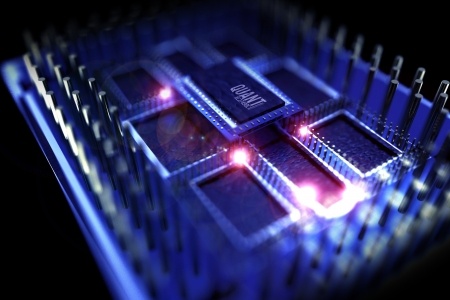 The ever-decreasing size of transistors and circuitry utilized in computing devices today are necessitating a push towards quantum computing, or computing architectures for performing operations with components utilizing quantum-mechanical phenomena. As transistor gates are made smaller and smaller, becoming close to the size of the electrons they’re meant to control for the proper transmission of data, the physics of classical computing will no longer be adequate to perform operations. The transition to quantum computing will require a greater scientific understanding of quantum phenomena, such as entanglement and superposition, as well as major technological advances such as the first-ever demonstration of a Fredkin gate last year in Australia.
The ever-decreasing size of transistors and circuitry utilized in computing devices today are necessitating a push towards quantum computing, or computing architectures for performing operations with components utilizing quantum-mechanical phenomena. As transistor gates are made smaller and smaller, becoming close to the size of the electrons they’re meant to control for the proper transmission of data, the physics of classical computing will no longer be adequate to perform operations. The transition to quantum computing will require a greater scientific understanding of quantum phenomena, such as entanglement and superposition, as well as major technological advances such as the first-ever demonstration of a Fredkin gate last year in Australia.
Research and development into quantum computing have been making some headlines recently. In early November, Armonk, NY-based information tech giant IBM (NYSE:IBM) announced two upgrades to its quantum computing technologies, branded as IBM Q, including an operational prototype of a processor which can perform quantum operations using 50 quantum bits, or qubits, for an average coherence time of 90 milliseconds; that may provide an incredibly short window of time to perform quantum operations, but IBM still leads the field in that regard. Academia is also becoming more invested in quantum computing R&D as is reflected in a recent New York Times article on quantum research being performed at Yale, MIT and elsewhere. Business startups in the field are also finding themselves to be valuable investments. Yale spin-off Quantum Circuits Inc. recently announced a round of funding which netted the firm $18 million which it will reportedly use to build and sell a practical quantum computing platform.
 Patenting activities in the quantum computing sector have also rapidly increased in recent years according to a quantum computing patent landscape report recently released by patent analytics advisory firm Patinformatics. Among the highlights of this report include a major increase in quantum computing patent family publications which are forecast to rise by 430 percent from less than 100 publications in 2014 up to more than 400 publications projected through 2017. That three-year period represents a significant statistical breakout compared to the 50 to 100 publications range which was generally experienced between 2003 and 2014. (NOTE: A single patent family includes all patent filings across various countries which cover the same inventive concept.)
Patenting activities in the quantum computing sector have also rapidly increased in recent years according to a quantum computing patent landscape report recently released by patent analytics advisory firm Patinformatics. Among the highlights of this report include a major increase in quantum computing patent family publications which are forecast to rise by 430 percent from less than 100 publications in 2014 up to more than 400 publications projected through 2017. That three-year period represents a significant statistical breakout compared to the 50 to 100 publications range which was generally experienced between 2003 and 2014. (NOTE: A single patent family includes all patent filings across various countries which cover the same inventive concept.)
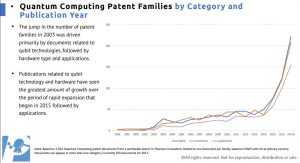 The recent Patinformatics quantum computing report, which primarily deals with inventions relating to the computing aspect itself and not necessarily specific applications, analyzes three areas of quantum computing patents: qubits, the computational units involved in quantum operations which are capable of existing in a variety of states; hardware, including the circuitry and gates for quantum devices, some of which are specific to certain types of qubits; and applications for quantum computing generally. 2017 projections indicate that qubit technologies will see the most patent family publications, followed closely by quantum hardware patents with quantum application patents placing at a not-too-distant third.
The recent Patinformatics quantum computing report, which primarily deals with inventions relating to the computing aspect itself and not necessarily specific applications, analyzes three areas of quantum computing patents: qubits, the computational units involved in quantum operations which are capable of existing in a variety of states; hardware, including the circuitry and gates for quantum devices, some of which are specific to certain types of qubits; and applications for quantum computing generally. 2017 projections indicate that qubit technologies will see the most patent family publications, followed closely by quantum hardware patents with quantum application patents placing at a not-too-distant third.
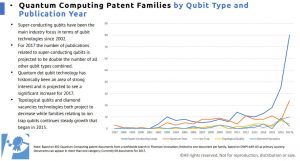 Within the qubit sector itself, super-conducting loop technology are seeing the greatest amount of interest from research and development firms. Projections for 2017 show that about 80 patent families related to super-conducting loop inventions will publish this year, a total which is nearly four times the number of patent families covering second-place quantum dot tech which are projected to publish this year. According to Anthony Trippe, Patinformatics’ managing director, this is a strong sign that super-conducting loop quantum computer technologies will be the first type of qubit technology to be commercially released. “It’s probably about five to ten years closer to market than what is seen in other literature,” Trippe said. He noted that some have discussed the potential of topological qubits, which is projected to be covered by a projected five patent families publishing this year, but that Microsoft (NASDAQ:MSFT) was the only tech firm investing heavily in that field. Quantum hardware patent filings are being driven by circuit-related technologies, while cryptography and annealing applications were major drivers among quantum application patent publications.
Within the qubit sector itself, super-conducting loop technology are seeing the greatest amount of interest from research and development firms. Projections for 2017 show that about 80 patent families related to super-conducting loop inventions will publish this year, a total which is nearly four times the number of patent families covering second-place quantum dot tech which are projected to publish this year. According to Anthony Trippe, Patinformatics’ managing director, this is a strong sign that super-conducting loop quantum computer technologies will be the first type of qubit technology to be commercially released. “It’s probably about five to ten years closer to market than what is seen in other literature,” Trippe said. He noted that some have discussed the potential of topological qubits, which is projected to be covered by a projected five patent families publishing this year, but that Microsoft (NASDAQ:MSFT) was the only tech firm investing heavily in that field. Quantum hardware patent filings are being driven by circuit-related technologies, while cryptography and annealing applications were major drivers among quantum application patent publications.
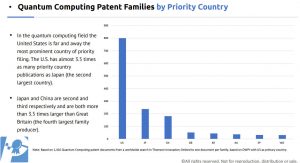 In terms of countries of priority for quantum computer patent application filings, the United States is by far the preferred jurisdiction for applicants. The U.S. has been the priority country listed on around 800 quantum computer patent publications, nearly 3.5 times the number of priority country publications from second-place Japan. China, in third-place, has nearly 200 priority country publications in the quantum computer space. However, since 2014, China has swapped places with Japan and China’s projected publication growth rate is expected to increase faster than Japan’s in the coming years. “People have been patenting in this space since the 1990s,” Trippe notes, “but it really hasn’t taken off until the 2014 timeframe. It’s one of those really unique technologies that people have known about for a long time and it hasn’t reached critical mass, but now things are accelerating rapidly.”
In terms of countries of priority for quantum computer patent application filings, the United States is by far the preferred jurisdiction for applicants. The U.S. has been the priority country listed on around 800 quantum computer patent publications, nearly 3.5 times the number of priority country publications from second-place Japan. China, in third-place, has nearly 200 priority country publications in the quantum computer space. However, since 2014, China has swapped places with Japan and China’s projected publication growth rate is expected to increase faster than Japan’s in the coming years. “People have been patenting in this space since the 1990s,” Trippe notes, “but it really hasn’t taken off until the 2014 timeframe. It’s one of those really unique technologies that people have known about for a long time and it hasn’t reached critical mass, but now things are accelerating rapidly.”
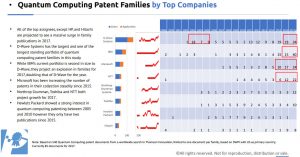 Among individual companies, it’s actually a Canadian firm which has the largest portfolio of patent families directed at quantum computing. British Columbia-based D-Wave Systems was an early developer in quantum computing, seeing 34 patent families published between 2003 and 2005. D-Wave has had a total of 170 patent families covering quantum computing published since 2002 and is projected to have 34 patent families publish this year. The highest projection for 2017 patent family publications, however, belongs to Armonk, NY-based tech giant IBM (NYSE:IBM), which is likely to have 60 patent families publish this year. Rounding out the top five companies by total number of patent families are Microsoft, Japan-based Nippon Telegraph and Telephone (NTT) (TYO:9432) and defense firm Northrop Grumman (NYSE:NOC). “The most fascinating thing for us is that when the media talks about the subject of quantum computing, all you’ll see is IBM, Microsoft, Google or D-Wave,” Trippe said. “You don’t see anything about NTT or Northrop Grumman.”
Among individual companies, it’s actually a Canadian firm which has the largest portfolio of patent families directed at quantum computing. British Columbia-based D-Wave Systems was an early developer in quantum computing, seeing 34 patent families published between 2003 and 2005. D-Wave has had a total of 170 patent families covering quantum computing published since 2002 and is projected to have 34 patent families publish this year. The highest projection for 2017 patent family publications, however, belongs to Armonk, NY-based tech giant IBM (NYSE:IBM), which is likely to have 60 patent families publish this year. Rounding out the top five companies by total number of patent families are Microsoft, Japan-based Nippon Telegraph and Telephone (NTT) (TYO:9432) and defense firm Northrop Grumman (NYSE:NOC). “The most fascinating thing for us is that when the media talks about the subject of quantum computing, all you’ll see is IBM, Microsoft, Google or D-Wave,” Trippe said. “You don’t see anything about NTT or Northrop Grumman.”
Among companies who are increasing their patent filing activities in the quantum computing space, Trippe notes that it’s interesting to see Nokia/Alcatel (NYSE:NOK) having a large increase in publications since 2016. Nokia has shown a recent interest in monetizing its patent portfolio by selling assets, including its August announcement that it would be unloading 4,260 patent families to anyone paying in cash. These patents were acquired in 2015 when Nokia bought Alcatel-Lucent. “They have a significant portfolio in the space and they’re a known seller,” Trippe said, noting that Nokia is likely near the top of the list in terms of companies looking to make patent deals in the quantum computing space.
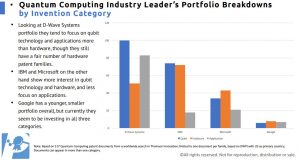 The Patinformatics quantum computing report also provides feedback on the sectors of quantum computing upon which patenting companies are focused. For instance, D-Wave systems has a particular interest in qubit patents with about 100 such patent families while IBM shows a stronger interest in hardware, where it outpaces D-Wave in publications. In terms of quantum hardware, IBM has taken a particular interest in circuit technologies whereas Microsoft looks to be the sole leader in logic gates. Most quantum application patent families are directed at general quantum processing methods but D-Wave has broken out in quantum annealing applications; the Patinformatics report finds that 33 percent of D-Wave’s entire portfolio is directed at quantum annealing. Trippe noted that among Chinese firms included in the patent landscape report, there appears to be a heavy interest in locking down the quantum cryptography sector of application inventions. “They’re clearly trying to corner the market on being able to use cryptographic methods to protect data from being cracked by quantum computers,” he said.
The Patinformatics quantum computing report also provides feedback on the sectors of quantum computing upon which patenting companies are focused. For instance, D-Wave systems has a particular interest in qubit patents with about 100 such patent families while IBM shows a stronger interest in hardware, where it outpaces D-Wave in publications. In terms of quantum hardware, IBM has taken a particular interest in circuit technologies whereas Microsoft looks to be the sole leader in logic gates. Most quantum application patent families are directed at general quantum processing methods but D-Wave has broken out in quantum annealing applications; the Patinformatics report finds that 33 percent of D-Wave’s entire portfolio is directed at quantum annealing. Trippe noted that among Chinese firms included in the patent landscape report, there appears to be a heavy interest in locking down the quantum cryptography sector of application inventions. “They’re clearly trying to corner the market on being able to use cryptographic methods to protect data from being cracked by quantum computers,” he said.
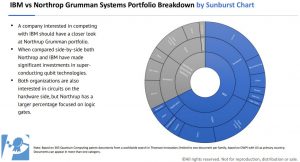 One interesting finding from the Patinformatics report is that, although Northrop Grumman doesn’t have the largest portfolio in the field, it is well-situated to compete with the biggest players. “One of our main assertions is that, if there’s an organization interested in being competitive with IBM, they may want to contemplate a partnership or acquisition of Northrop Grumman,” Trippe said. Both Northrop and IBM have made significant investments into super-conducting loop qubit technologies and Northrop actually edges IBM in logic gate hardware. “In order to compete with IBM, we think that there will be some consolidation,” Trippe said. “Companies that no one is talking about today will be key players in that universe.”
One interesting finding from the Patinformatics report is that, although Northrop Grumman doesn’t have the largest portfolio in the field, it is well-situated to compete with the biggest players. “One of our main assertions is that, if there’s an organization interested in being competitive with IBM, they may want to contemplate a partnership or acquisition of Northrop Grumman,” Trippe said. Both Northrop and IBM have made significant investments into super-conducting loop qubit technologies and Northrop actually edges IBM in logic gate hardware. “In order to compete with IBM, we think that there will be some consolidation,” Trippe said. “Companies that no one is talking about today will be key players in that universe.”
Patinformatics’ patent report also includes spatial concept map analysis of emerging companies in the quantum computing space and the sectors being covered by their patenting activities. Some startups have a wider scope of patent family publications, such as Somerville, MA-based MagiQ which has invested in encryption applications, photon generation and processor hardware, as well as some qubit technologies. By contrast, Australian firm Qucor and Irish firm Element Six are more narrowly focused on qubit tech, especially within super-conducting loops and diamond vacancies.
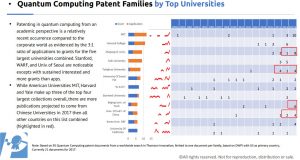 The contributions of the academic world to the quantum computing patent landscape cannot be overlooked either according to the Patinformatics report. The top three universities in the field include two American institutions, MIT and Harvard, and a Chinese school in third place, Zhejiang University. “It’s pretty clear that eventually, that IP is going to end up with somebody,” Trippe said. “There are going to be collaborations that take place coming from these primarily Western universities.” Data on what these academic patents cover suggest that Chinese institutions, much like many Chinese companies, aren’t interested so much in hardware inventions as locking down applications, especially cryptography. Chinese universities are projected to have more patent families published in 2017 than U.S. universities.
The contributions of the academic world to the quantum computing patent landscape cannot be overlooked either according to the Patinformatics report. The top three universities in the field include two American institutions, MIT and Harvard, and a Chinese school in third place, Zhejiang University. “It’s pretty clear that eventually, that IP is going to end up with somebody,” Trippe said. “There are going to be collaborations that take place coming from these primarily Western universities.” Data on what these academic patents cover suggest that Chinese institutions, much like many Chinese companies, aren’t interested so much in hardware inventions as locking down applications, especially cryptography. Chinese universities are projected to have more patent families published in 2017 than U.S. universities.
(NOTE: Slides reproduced here with permission from Patinformatics.)

![[IPWatchdog Logo]](https://ipwatchdog.com/wp-content/themes/IPWatchdog%20-%202023/assets/images/temp/logo-small@2x.png)

![[Advertisement]](https://ipwatchdog.com/wp-content/uploads/2024/05/LexisNexis-May-16-2024-sidebar-700x500-1.jpg)
![[Advertisement]](https://ipwatchdog.com/wp-content/uploads/2024/04/Patent-Litigation-Masters-2024-sidebar-last-chance-700x500-1.jpg)
![[Advertisement]](https://ipwatchdog.com/wp-content/uploads/2024/05/Patent-Portfolio-Management-2024-sidebar-super-early-bird-with-button-700x500-1.jpg)
![[Advertisement]](https://ipwatchdog.com/wp-content/uploads/2024/05/Artificial-Intelligence-2024-Getting-AI-Patents-Allowed-sidebar-700x500-1.jpeg)

![[Advertisement]](https://ipwatchdog.com/wp-content/uploads/2021/12/WEBINAR-336-x-280-px.png)
![[Advertisement]](https://ipwatchdog.com/wp-content/uploads/2021/12/2021-Patent-Practice-on-Demand-recorded-Feb-2021-336-x-280.jpg)
![[Advertisement]](https://ipwatchdog.com/wp-content/uploads/2021/12/Ad-4-The-Invent-Patent-System™.png)



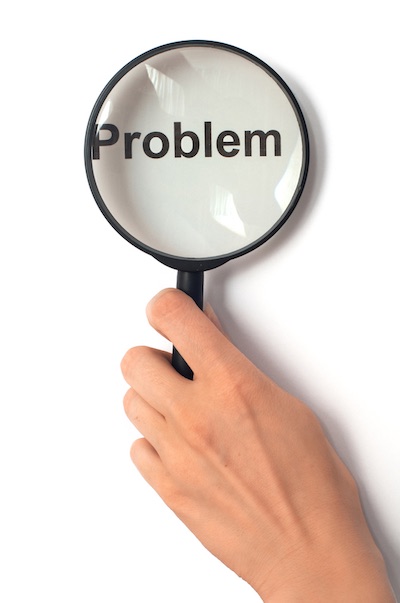



Join the Discussion
3 comments so far.
Paul Nation
December 22, 2017 12:39 pmAs a researcher in quantum computing, leaving Northrop Grumman and moving to IBM, I can say with certainty that this statement:
“contemplate a partnership or acquisition of Northrop Grumman”
is horrible advice.
Steve Brachmann
December 9, 2017 08:56 am@patent leather – That’s a tough call for me to make as I am not a computer scientist and I haven’t seen what the current state of development is in the actual R&D facilities myself. That said, given the recent spurt of patent filings in the field, I’d be interested to see where development stands around the year 2025. We seem to be in an interesting space where basic research at the academic level is taking place alongside developments by major tech players and small, more focused start-ups, so there seems like the sector’s seeing a lot of development activity currently from a variety of entities which could speed development. Also, I wouldn’t be so quick to discount blockchain cryptocurrencies in the face of quantum computing. Yes, the private keys would be much easier to compute but the cryptography enabled by quantum computing would also be much stronger than it is today. I have a piece coming up about blockchain tech and I’ll be speaking with an expert and I’ll have to ask about the implications of quantum computing, there might be some interesting answers to that.
patent leather
December 5, 2017 10:51 pmSteve, how far do you think we are from actually having a working quantum computer? Ironic that another recent article on IPW is about bitcoin, once working quantum computers are realized, there will be no more bitcoin because quantum computers could instantly compute private keys, causing all hell to break loose.